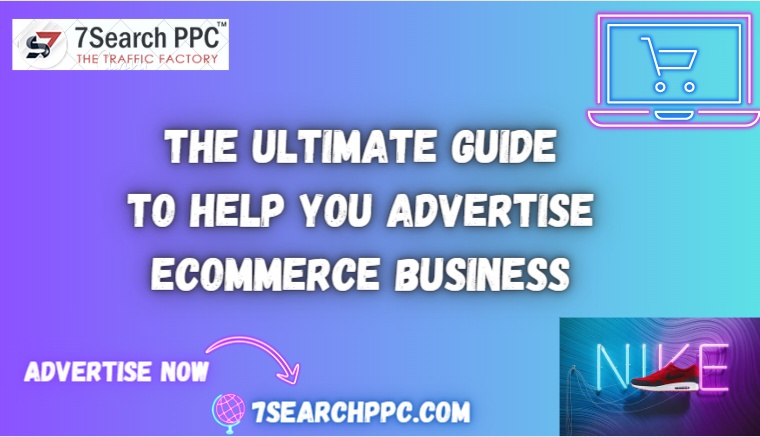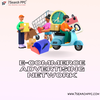Effective advertising may make all the difference in luring clients and boosting sales in the fast-paced world of e-commerce. Advertising has changed tremendously with the rise of digital platforms, providing a wide range of possibilities to reach your target demographic. This manual aims to provide you a thorough grasp of the best ways to use advertisements to promote ecommerce business.

Understanding the Landscape
It's essential to understand the advertising landscape before diving into the plans and approaches. Ecommerce advertising mostly occurs online and is divided into the following categories:
Search Engine Advertising:
Pay-Per-Click (PPC) advertisements on search engines like Google and Bing are known as search engine advertising.
Social Media Advertising:
Ads on well-known networks like Facebook, Instagram, Twitter, and LinkedIn are referred to as social media advertising.
Display Advertising:
Advertising that appears as images or videos on websites, mobile applications, or social media.
Email Marketing:
Email marketing is the practice of sending advertisements to current and potential clients.
Collaborations with people who have a sizable internet following in order to promote your ecommerce business is known as influencer marketing.
Influencer Marketing:
Partnering with affiliates to market your items and pay them a percentage on sales is known as affiliate marketing.
Affiliate Marketing:
Each kind offers special advantages and alternatives for targeting. It's crucial to select the appropriate mix based on your target market, product, and spending limit.
Crafting a Winning Strategy
Recognize Your Audience:
To determine the tastes, behaviors, and demographics of your target audience, do in-depth market research. Create ads that are relevant to this audience.
Clear Your Goals:
Set clear, quantifiable objectives for your marketing activities. Having specific objectives will direct your plan, whether your goal is to raise brand awareness, drive sales, or increase website traffic.
Smart Spending:
Based on your objectives and the possible return on investment (ROI), allocate your advertising budget. Beginning with a moderate budget, you may increase it as you learn what works best.
Make Engaging Ad Content:
Create attention-grabbing, pertinent, and interesting advertising material that conveys your USP. Make use of compelling writing, crisp calls to action, and high-quality graphics.
Utilize A/B Testing:
Try out many ad iterations to see which ones connect with your target demographic. To maximize performance, experiment with features including headlines, graphics, ad formats, and CTAs.
Exploring Advertising Channels
(PPC) Search Engine Marketing
Utilizing Google Ads, develop customized campaigns with terms associated with your items. To get consumers to click and learn more about your offers, improve your ad copy.
Use the Bing advertising platform to connect with a diverse audience base. Adapt your adverts to the Bing user base.
Social Media Promotion
Facebook:
Use Facebook's sophisticated targeting tools to connect with particular demographics, hobbies, and behaviors on Facebook and Instagram. On both platforms, use visuals to highlight your items.
Twitter:
Use Twitter advertisements to get in a more chatty audience. To advertise your ecommerce website, use popular hashtags and clear messages.
LinkedIn:
If your e-commerce company serves a B2B market, target professionals and companies with LinkedIn advertisements.
Dispatch Marketing
Use the Google Display Network (GDN) to target individuals based on their surfing habits and interests by displaying image or video adverts across a wide network of websites.
Retargeting:
Run retargeting efforts to re-engage website visitors who browsed your site but didn't buy anything. Remind them about your offerings to boost conversions.
Segmented email campaigns for email marketing
Create email list segments based on user behavior, preferences, and past purchases. For more engagement and conversions, customize the content of your emails for each section.
Automated Email Flows:
To foster client connections and increase sales, set up automated email flows like welcome emails, cart abandonment reminders, and post-purchase follow-ups.
Using influencers
Find the Right Influencers:
Work together with influencers in your field whose followers are members of your target demographic. Make sure that product endorsements are sincere and honest.
Influencers can produce sponsored content that features your brand. This may greatly increase your credibility and audience.
Affiliate Promotion
Select the Best Affiliates:
Construct a partnership with affiliates whose customers are interested in your offerings. The best way to advertise ecommerce business is to provide them alluring commissions.
Track and improve:
Keep track of affiliate performance with tracking tools. Improve your collaborations depending on what produces the greatest outcomes.
Monitoring and Optimization
Track Important data:
Keep track of important data including the click-through rate (CTR), conversion rate, cost per acquisition (CPA), and return on advertising spend (ROAS). To make wise judgments, analyze this data.
Improve Frequently:
Continually improve your advertising tactics in light of performance data. To maximize ROI, change targeting, messaging, and budgets.
Keep Up to Date:
The digital environment is always evolving. To keep your advertising efforts effective, stay up to date on the most recent trends, algorithm changes, and best practices.
Conclusion
In conclusion, effective ecommerce advertising platforms require knowing your target market, establishing specific objectives, picking the best advertising platforms, creating engaging content, and regularly tracking and fine-tuning your campaigns. Utilizing the effectiveness of online advertising, you may boost sales, improve traffic, and establish a powerful brand presence in the cutthroat ecommerce market.
Frequently Asked Questions (FAQ’s)
- How do I monetize my website with ads?
Ways to monetize a website
- Google AdSense. You can generate income by allowing Google to place ads on your website. ...
- Direct advertising. ...
- Affiliate marketing. ..
- 7Search PPC…
- What is the eligibility to monetize a website?
You can get approved by Google Adsense if you own the website, are 18+ years of age, have enough unique content and technical pages set up in an approved language, and lastly, have enough organic traffic. Here is a quick checklist for you to cross-check if you are eligible for Google Adsense approval.
- What is advertising on networks in e-commerce?
An advertising network, or ad network, connects businesses that want to run advertisements with websites that wish to host them. The principal attribute of an ad network is the gathering of ad space and matching it with the advertiser's needs.


No comments yet